Impacts of Changing Temperatures on the Water Budget in the Great Salt Lake Basin
Abstract
1. Introduction
2. Study Area, Data and Methods
2.1. Study Area
2.2. Data and Methods
3. Results and Discussion
3.1. Various Temperature Thresholds
3.2. Effects of Temperature Warming
4. Conclusions
Author Contributions
Funding
Data Availability Statement
Acknowledgments
Conflicts of Interest
References
- Dettinger, M.; Udall, B.; Georgakakos, A. Western water and climate change. Ecol. Appl. 2015, 25, 2069–2093. [Google Scholar] [CrossRef] [PubMed]
- dos Santos, C.A.C.; Neale, C.M.U.; Rao, T.V.R.; da Silva, B.B. Trends in indices for extremes in daily temperature and precipitation over Utah, USA. Int. J. Climatol. 2011, 31, 1813–1822. [Google Scholar] [CrossRef]
- Mohammed, I.N.; Tarboton, D.G. An examination of the sensitivity of the Great Salt Lake to changes in inputs. Water Resour. Res. 2012, 48. [Google Scholar] [CrossRef]
- Khatri, K.; Strong, C. Climate Change, Water Resources, and Potential Adaptation Strategies in Utah; Division of Water Resources, Utah Department of Natural: Salt Lake City, UT, USA, 2020.
- Uwamahoro, S.; Liu, T.; Nzabarinda, V.; Li, Z.Y.; Umugwaneza, A.; Maniraho, A.P.; Kayumba, P.M.; Gulakhmadov, A.; Anming, B.; Abdullaev, F. Climatic and anthropogenic impacts on the water balance of Issyk-Kul Lake through its main catchments. Front. Water 2024, 6. [Google Scholar] [CrossRef]
- Adam, J.C.; Hamlet, A.F.; Lettenmaier, D.P. Implications of global climate change for snowmelt hydrology in the twenty-first century. Hydrol. Process. 2009, 23, 962–972. [Google Scholar] [CrossRef]
- Barnhart, T.B.; Molotch, N.P.; Livneh, B.; Harpold, A.A.; Knowles, J.F.; Schneider, D. Snowmelt rate dictates streamflow. Geophys. Res. Lett. 2016, 43, 8006–8016. [Google Scholar] [CrossRef]
- Dunne, T.; Black, R.D. Runoff Processes during Snowmelt. Water Resour. Res. 1971, 7, 1160–1172. [Google Scholar] [CrossRef]
- Tarboton, D.G.; Luce, C.H. Utah Energy Balance Snow Accumulation and Melt Model (UEB); Utah Water Research Laboratory: Logan, UT, USA, 1997. [Google Scholar]
- Aydin, M.C.; Gelberi, G.; Ulu, A.E. Investigation of recent level changes in Lake Van using water balance, LSTM and ANN approaches. Appl. Water Sci. 2024, 14, 41. [Google Scholar] [CrossRef]
- Zaerpour, M.; Hatami, S.; Ballarin, A.S.; Knoben, W.J.M.; Papalexiou, S.M.; Pietroniro, A.; Clark, M.P. Impacts of agriculture and snow dynamics on catchment water balance in the U.S. and Great Britain. Commun. Earth Environ. 2024, 5, 733. [Google Scholar] [CrossRef] [PubMed]
- DeWalle, D.R.; Rango, A. Principles of Snow Hydrology; Cambridge University Press: Cambridge, UK, 2008. [Google Scholar]
- Armstrong, R.L.; Brun, E. Snow and Climate: Physical Processes, Surface Energy Exchange and Modeling; Cambridge University Press: Cambridge, UK, 2008. [Google Scholar]
- Beaton, A.D.; Han, M.; Tolson, B.A.; Buttle, J.M.; Metcalfe, R.A. Assessing the impact of distributed snow water equivalent calibration and assimilation of Copernicus snow water equivalent on modelled snow and streamflow performance. Hydrol. Process. 2024, 38, e15075. [Google Scholar] [CrossRef]
- Javadinejad, S.; Dara, R.; Jafary, F. Climate Change Scenarios and Effects on Snow-Melt Runoff. Civ. Eng. J. 2020, 6, 1715–1725. [Google Scholar] [CrossRef]
- Wright, T.E.; Stuivenvolt-Allen, J.; Affram, G.; Hasan, N.A.; Ratterman, C.; Zhang, W. Responses of Extreme Discharge to Changes in Surface-Air and Dewpoint Temperatures in Utah: Seasonality and Mechanisms. Water 2023, 15, 688. [Google Scholar] [CrossRef]
- Zhang, W. The dry and hot American Southwest under the present and future climates. Atmos. Ocean. Sci. Lett. 2023, 16, 100340. [Google Scholar] [CrossRef]
- Sinyukovich, V.N.; Georgiadi, A.G.; Groisman, P.Y.; Borodin, O.O.; Aslamov, I.A. The Variation in the Water Level of Lake Baikal and Its Relationship with the Inflow and Outflow. Water 2024, 16, 560. [Google Scholar] [CrossRef]
- Thomas, S.; Lucius, M.A.; Kim, J.-Y.; Everham, E.M.; Dettmar, D.L.; Missimer, T.M. Water Budget for Lake Trafford, a Natural Subtropical Lake in South Florida: An Example of Enhanced Groundwater Influx in a Subtropical Lake Subsequent to Organic Sediment Dredging. Water 2024, 16, 1188. [Google Scholar] [CrossRef]
- Affram, G.; Zhang, W.; Hipps, L.; Ratterman, C. Characterizing the development and drivers of 2021 Western US drought. Environ. Res. Lett. 2023, 18, 044040. [Google Scholar] [CrossRef]
- Jennings, K.S.; Winchell, T.S.; Livneh, B.; Molotch, N.P. Spatial variation of the rain–snow temperature threshold across the Northern Hemisphere. Nat. Commun. 2018, 9, 1148. [Google Scholar] [CrossRef]
- Harpold, A.A.; Kaplan, M.L.; Klos, P.Z.; Link, T.; McNamara, J.P.; Rajagopal, S.; Schumer, R.; Steele, C.M. Rain or snow: Hydrologic processes, observations, prediction, and research needs. Hydrol. Earth Syst. Sci. 2017, 21, 1–22. [Google Scholar] [CrossRef]
- McDonald, G. Great Salt Lake Biology A Terminal Lake in a Time of Change. The Rozel Point Tar Seeps and Their Impact on the Local Biology at Great Salt Lake, Utah. 1 January 2020. Available online: https://www.academia.edu/43948143/Great_Salt_Lake_Biology_A_Terminal_Lake_in_a_Time_of_Change (accessed on 6 November 2024).
- Wine, M.L.; Null, S.E.; DeRose, R.J.; Wurtsbaugh, W.A. Climatization—Negligent Attribution of Great Salt Lake Desiccation: A Comment on Meng (2019). Climate 2019, 7, 67. [Google Scholar] [CrossRef]
- Merck, M.; Tarboton, D.G. Evaluating Variations in Great Salt Lake Inflow to Infer Human Consumptive Water Use, A Volume Reconstruction Approach. Available online: https://www.authorea.com/users/720996/articles/705972-evaluating-variations-in-great-salt-lake-inflow-to-infer-human-consumptive-water-use-a-volume-reconstruction-approach (accessed on 19 January 2025).
- Seltenrich, N. A Terminal Case? Shrinking Inland Seas Expose Salty Particulates and More. Environ. Health Perspect. 2023, 131, 062001. [Google Scholar] [CrossRef]
- Wurtsbaugh, W.; Miller, C.; Null, S.; Wilcock, P.; Hahnenberger, M.; Howe, F. Impacts of Water Development on Great Salt Lake and the Wasatch Front. Watershed Sciences Faculty Publications. 24 February 2016. Available online: https://digitalcommons.usu.edu/wats_facpub/875 (accessed on 6 November 2024). [CrossRef]
- Loving, B.L.; Waddell, K.M.; Miller, C.W. Water and Salt Balance of Great Salt Lake, Utah, and Simulation of Water and Salt Movement Through the Causeway, 1987–1998. U.S. Geological Survey; 2000. Report No.: 2000-4221. Available online: https://pubs.usgs.gov/publication/wri004221 (accessed on 6 November 2024). [CrossRef]
- Xu, H.; Duan, Y.; Li, Y.; Wang, H. Indirect Effects of Binary Typhoons on an Extreme Rainfall Event in Henan Province, China From 19 to 21 July 2021: 2. Numerical Study. J. Geophys. Res. Atmos. 2022, 127, e2021JD036083. [Google Scholar] [CrossRef]
- Friedl, M.A.; Brodley, C.E. Decision tree classification of land cover from remotely sensed data. Remote Sens. Environ. 1997, 61, 399–409. [Google Scholar] [CrossRef]
- Liaw, A.; Wiener, M. Classification and Regression by randomForest. R News 2002, 2, 18–22. [Google Scholar]
- Hastie, T.; Tibshirani, R.; Friedman, J. The Elements of Statistical Learning; Springer Series in Statistics; Springer: New York, NY, USA, 2009; Available online: http://link.springer.com/10.1007/978-0-387-84858-7 (accessed on 6 November 2024). [CrossRef]
- Breiman, L. Random Forests. Mach. Learn. 2001, 45, 5–32. [Google Scholar] [CrossRef]
- Chen, T.; Guestrin, C. XGBoost: A Scalable Tree Boosting System. In Proceedings of the 22nd ACM SIGKDD International Conference on Knowledge Discovery and Data Mining, KDD’16, San Francisco, CA, USA, 13–17 August 2016; Association for Computing Machinery: New York, NY, USA, 2016; pp. 785–794. Available online: https://dl.acm.org/doi/10.1145/2939672.2939785 (accessed on 6 November 2024). [CrossRef]
- Wi, S.; Ray, P.; Demaria, E.M.C.; Steinschneider, S.; Brown, C. A user-friendly software package for VIC hydrologic model development. Environ. Model. Softw. 2017, 98, 35–53. [Google Scholar] [CrossRef]
- Hersbach, H.; Bell, B.; Berrisford, P.; Hirahara, S.; Horányi, A.; Muñoz-Sabater, J.; Nicolas, J.; Peubey, C.; Radu, R.; Schepers, D.; et al. The ERA5 global reanalysis. Q. J. R. Meteorol. Soc. 2020, 146, 1999–2049. [Google Scholar] [CrossRef]
- Bell, B.; Hersbach, H.; Simmons, A.; Berrisford, P.; Dahlgren, P.; Horányi, A.; Muñoz-Sabater, J.; Nicolas, J.; Radu, R.; Schepers, D.; et al. The ERA5 global reanalysis: Preliminary extension to 1950. Q. J. R. Meteorol. Soc. 2021, 147, 4186–4227. [Google Scholar] [CrossRef]
- Ault, T.R. On the essentials of drought in a changing climate. Science 2020, 368, 256–260. [Google Scholar] [CrossRef]
- Gyasi-Agyei, Y. Evaluation of the effects of temperature changes on fine timescale rainfall. Water Resour. Res. 2013, 49, 4379–4398. [Google Scholar] [CrossRef]
- Trenberth, K.E. Conceptual Framework for Changes of Extremes of the Hydrological Cycle with Climate Change. Clim. Change 1999, 42, 327–339. [Google Scholar] [CrossRef]
- Berg, P.; Haerter, J.O.; Thejll, P.; Piani, C.; Hagemann, S.; Christensen, J.H. Seasonal characteristics of the relationship between daily precipitation intensity and surface temperature. J. Geophys. Res. Atmos. 2009, 114. [Google Scholar] [CrossRef]
- Nolin, A.W.; Daly, C. Mapping “At Risk” Snow in the Pacific Northwest. 1 October 2006. Available online: https://journals.ametsoc.org/view/journals/hydr/7/5/jhm543_1.xml (accessed on 2 December 2024). [CrossRef]
- Sowby, R.B. Utah Is Not the Second-Driest State: A Lesson in Questioning Persistent Assumptions about Hydrology. J. Hydrol. Eng. 2024, 29, 02523001. [Google Scholar] [CrossRef]
- Tian, W.; Liu, X.; Liu, C.; Bai, P. Investigation and simulations of changes in the relationship of precipitation-runoff in drought years. J. Hydrol. 2018, 565, 95–105. [Google Scholar] [CrossRef]
- Musselman, K.N.; Clark, M.P.; Liu, C.; Ikeda, K.; Rasmussen, R. Slower snowmelt in a warmer world. Nat. Clim. Change 2017, 7, 214–219. [Google Scholar] [CrossRef]
- Cook, B.I.; Mankin, J.S.; Anchukaitis, K.J. Climate Change and Drought: From Past to Future. Curr. Clim. Change Rep. 2018, 4, 164–179. [Google Scholar] [CrossRef]
- Rush, M.J.; Rajaram, H. Influence of Snowpack Cold Content on Seasonally Frozen Ground and Its Hydrologic Consequences: A Case Study From Niwot Ridge, CO. Water Resour. Res. 2022, 58, e2021WR031911. [Google Scholar] [CrossRef]
- McCabe, G.J.; Clark, M.P. Trends and Variability in Snowmelt Runoff in the Western United States. 1 August 2005. Available online: https://journals.ametsoc.org/view/journals/hydr/6/4/jhm428_1.xml (accessed on 12 November 2024). [CrossRef]
- Rhoades, A.M.; Jones, A.D.; Ullrich, P.A. The Changing Character of the California Sierra Nevada as a Natural Reservoir. Geophys. Res. Lett. 2018, 45, 13008–13019. [Google Scholar] [CrossRef]
- Khatri, K.B.; Strong, C.; Kochanski, A.K.; Burian, S.; Miller, C.; Hasenyager, C. Water Resources Criticality Due to Future Climate Change and Population Growth: Case of River Basins in Utah, USA. J. Water Resour. Plan. Manag. 2018, 144, 04018041. [Google Scholar] [CrossRef]
- EPA. Snowpack Change in the Western United States. ArcGIS StoryMaps. 17 January 2025. Available online: https://storymaps.arcgis.com/stories/65e98242e6a74c0db0932b1e2abe7051 (accessed on 20 January 2025).
- Pierce, D.W.; Cayan, D.R.; Feldman, D.R.; Risser, M.D. Future Increases in North American Extreme Precipitation in CMIP6 Downscaled with LOCA. 1 June 2023. Available online: https://journals.ametsoc.org/view/journals/hydr/24/5/JHM-D-22-0194.1.xml (accessed on 12 November 2024). [CrossRef]
- Barnett, T.P.; Adam, J.C.; Lettenmaier, D.P. Potential impacts of a warming climate on water availability in snow-dominated regions. Nature 2005, 438, 303–309. [Google Scholar] [CrossRef]
- Gillies, R.R.; Wang, S.-Y.; Booth, M.R. Observational and Synoptic Analyses of the Winter Precipitation Regime Change over Utah. 1 July 2012. Available online: https://journals.ametsoc.org/view/journals/clim/25/13/jcli-d-11-00084.1.xml (accessed on 20 January 2025). [CrossRef]
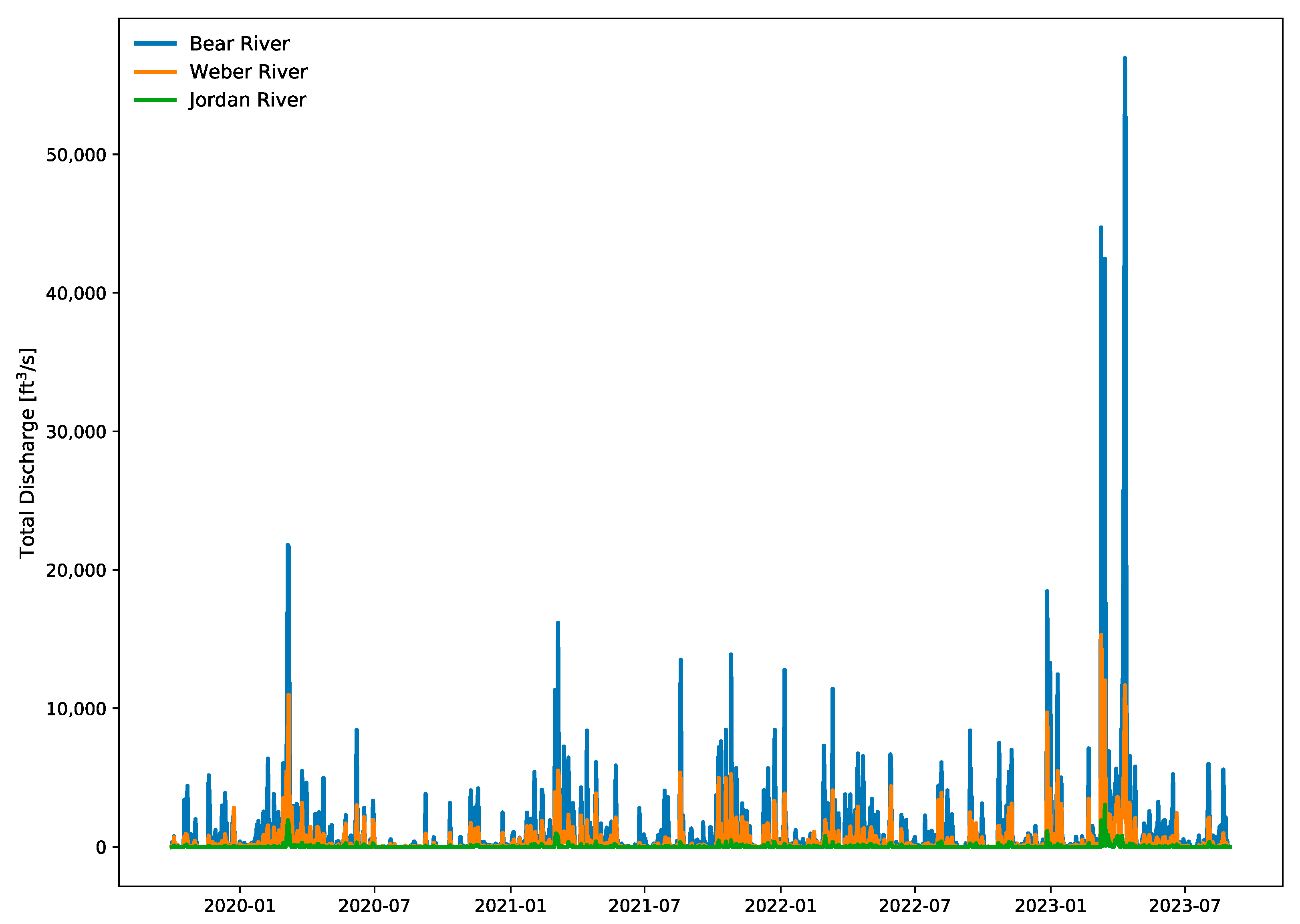
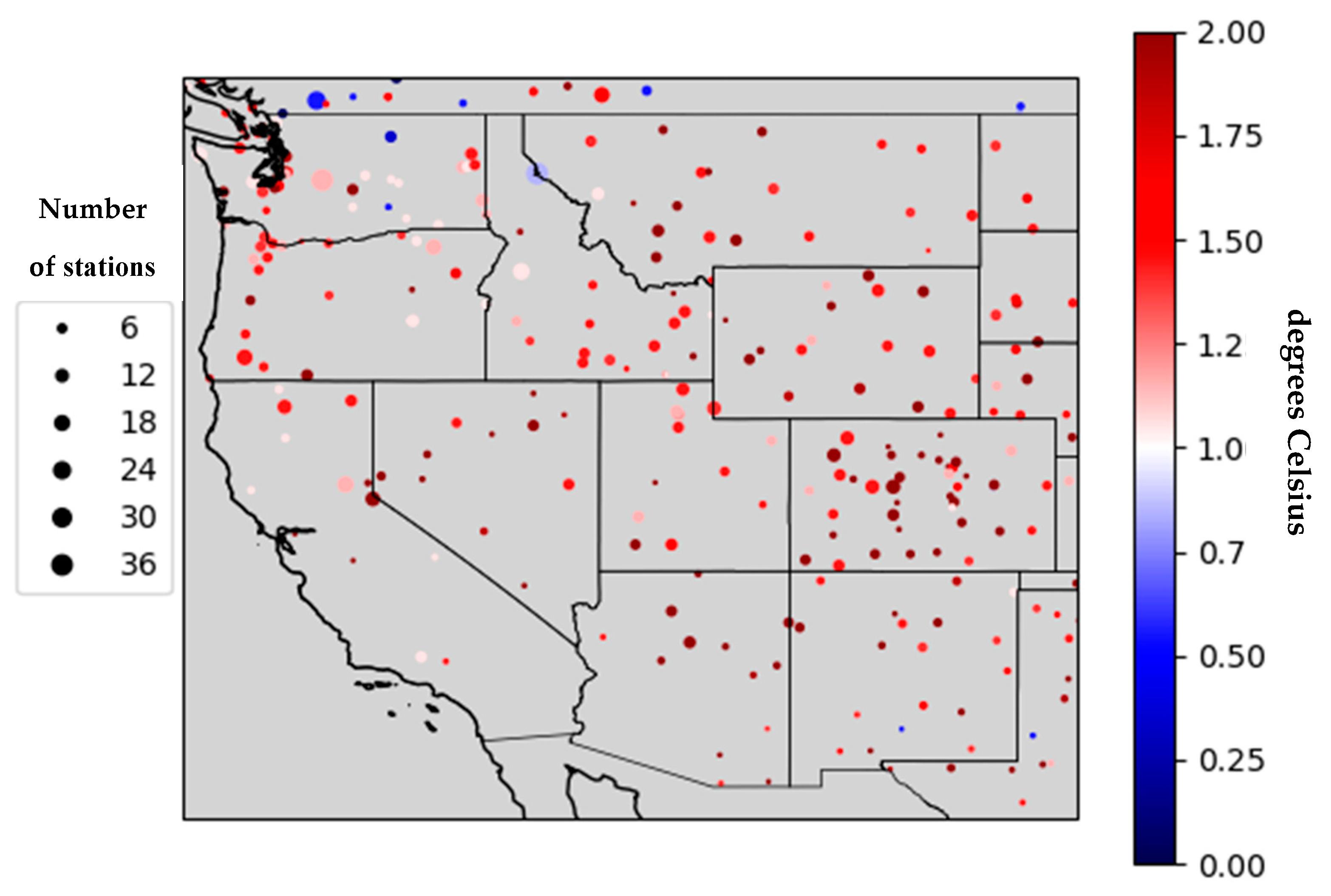
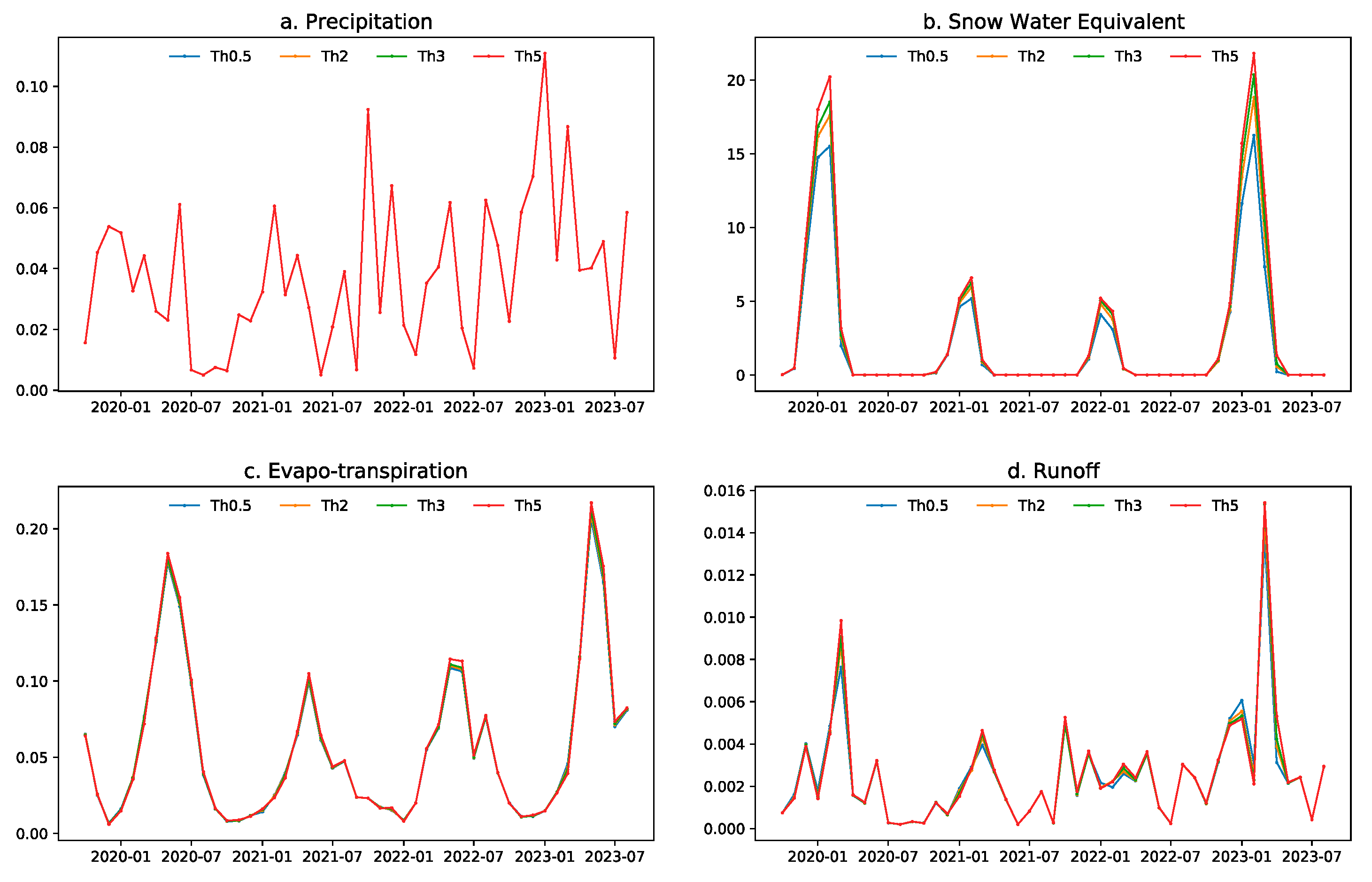
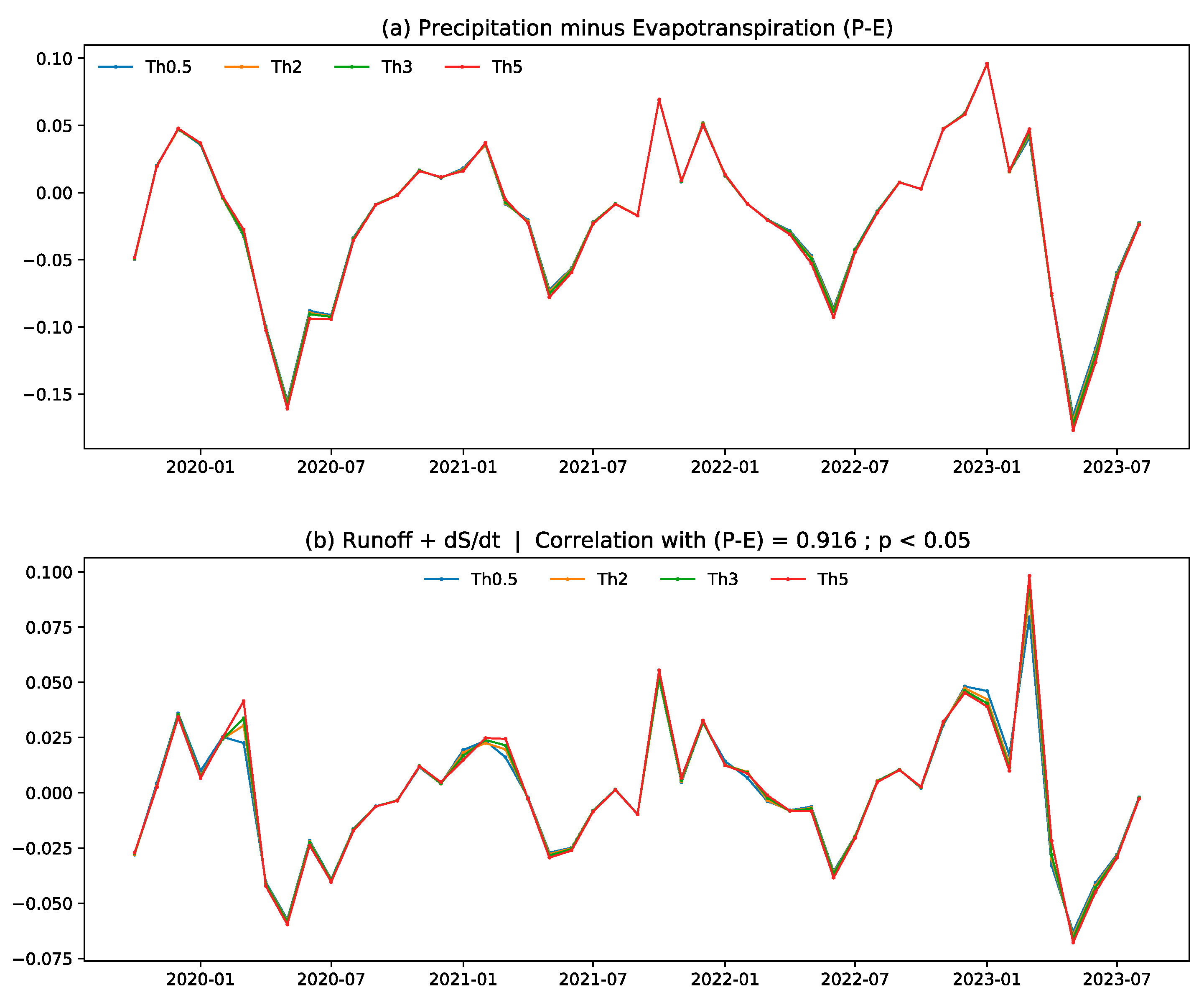
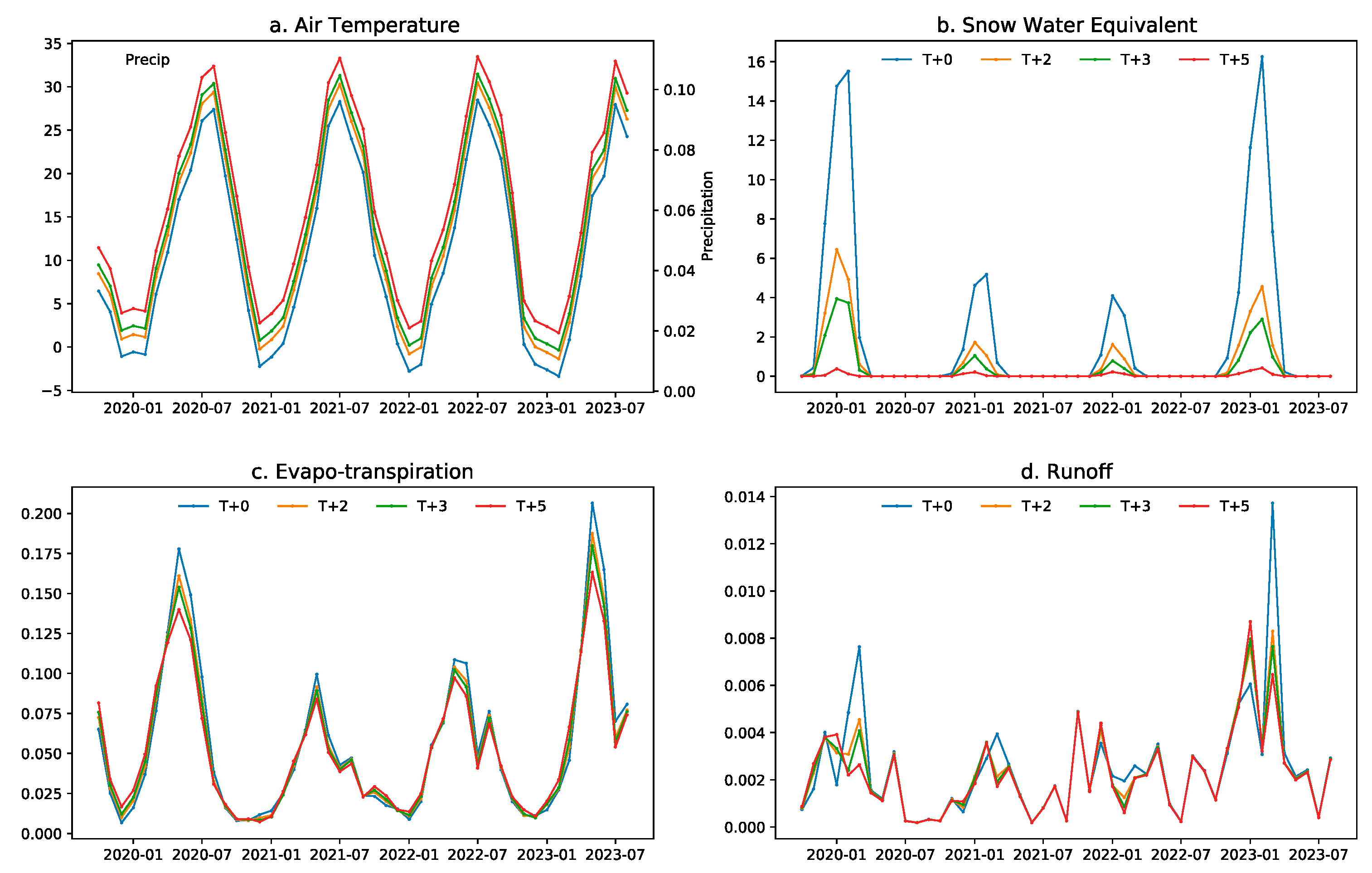
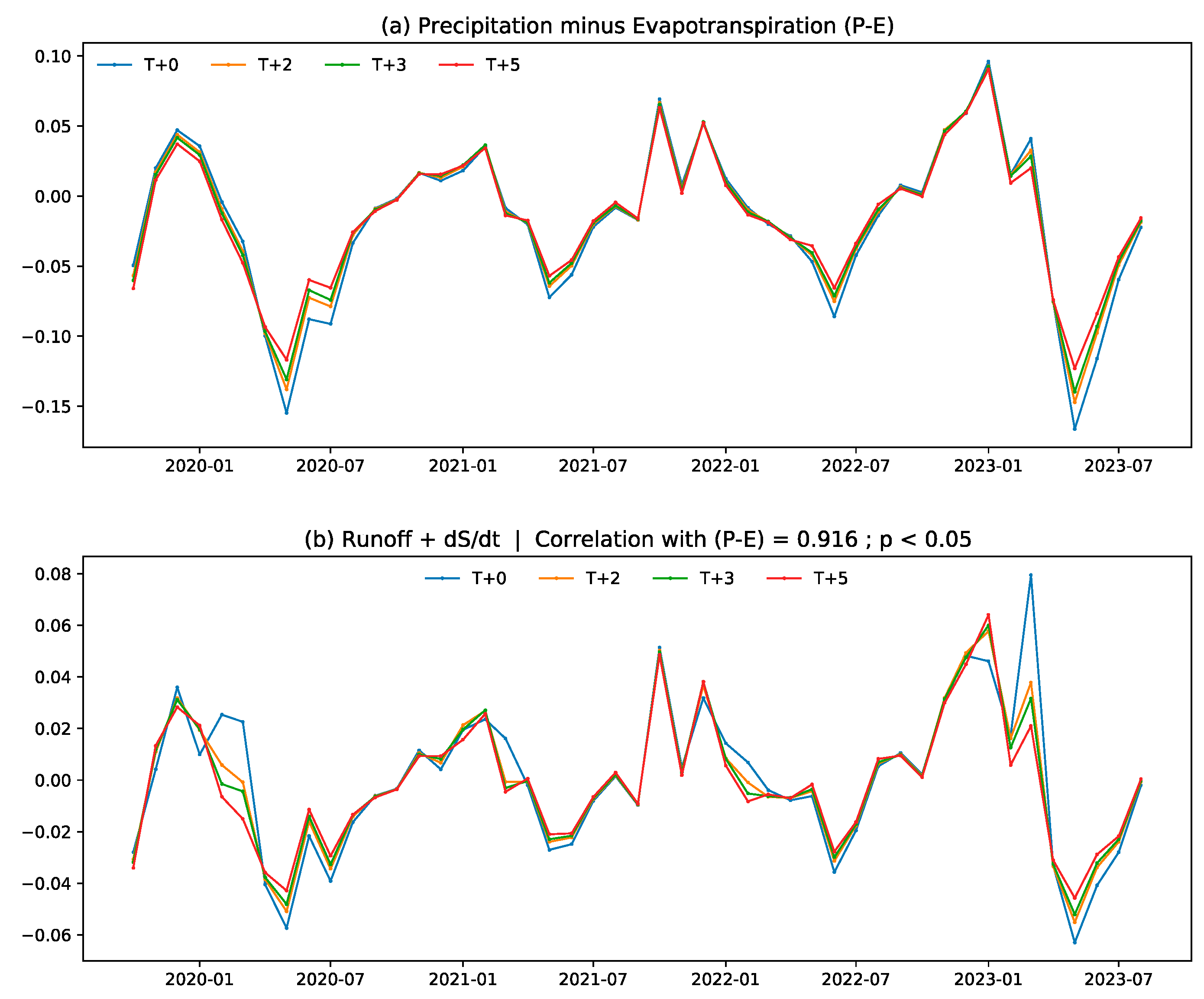
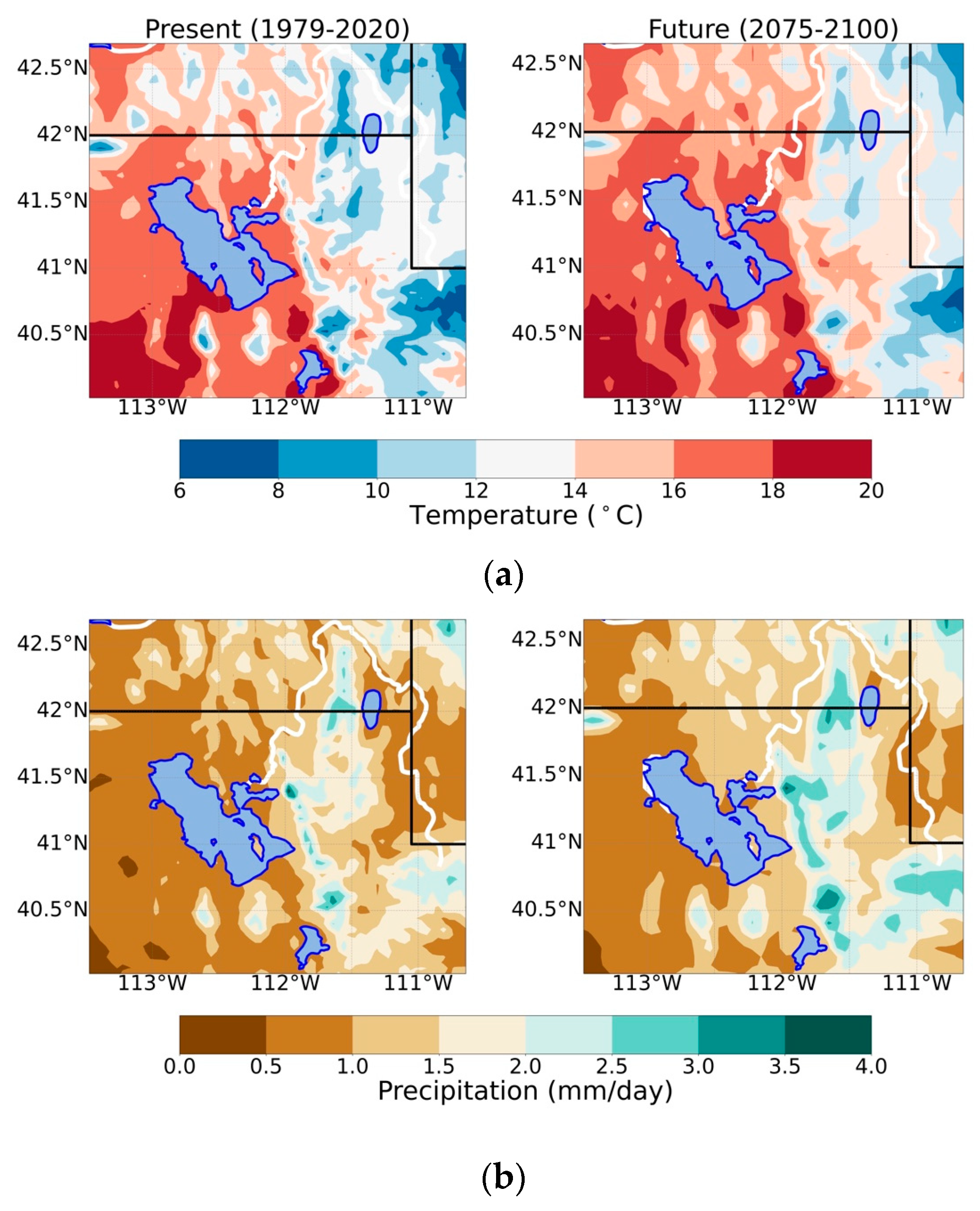
Disclaimer/Publisher’s Note: The statements, opinions and data contained in all publications are solely those of the individual author(s) and contributor(s) and not of MDPI and/or the editor(s). MDPI and/or the editor(s) disclaim responsibility for any injury to people or property resulting from any ideas, methods, instructions or products referred to in the content. |
© 2025 by the authors. Licensee MDPI, Basel, Switzerland. This article is an open access article distributed under the terms and conditions of the Creative Commons Attribution (CC BY) license (https://creativecommons.org/licenses/by/4.0/).
Share and Cite
Affram, G.; Othman, J.; Morovati, R.; Castellanos, S.P.; Khoshnoodmotlagh, S.; Dunn, D.; Dority, B.; Diaz, K.O.; Ratterman, C.; Zhang, W. Impacts of Changing Temperatures on the Water Budget in the Great Salt Lake Basin. Water 2025, 17, 420. https://doi.org/10.3390/w17030420
Affram G, Othman J, Morovati R, Castellanos SP, Khoshnoodmotlagh S, Dunn D, Dority B, Diaz KO, Ratterman C, Zhang W. Impacts of Changing Temperatures on the Water Budget in the Great Salt Lake Basin. Water. 2025; 17(3):420. https://doi.org/10.3390/w17030420
Chicago/Turabian StyleAffram, Grace, Jihad Othman, Reza Morovati, Saddy Pineda Castellanos, Sajad Khoshnoodmotlagh, Diana Dunn, Braedon Dority, Katherine Osorio Diaz, Cody Ratterman, and Wei Zhang. 2025. "Impacts of Changing Temperatures on the Water Budget in the Great Salt Lake Basin" Water 17, no. 3: 420. https://doi.org/10.3390/w17030420
APA StyleAffram, G., Othman, J., Morovati, R., Castellanos, S. P., Khoshnoodmotlagh, S., Dunn, D., Dority, B., Diaz, K. O., Ratterman, C., & Zhang, W. (2025). Impacts of Changing Temperatures on the Water Budget in the Great Salt Lake Basin. Water, 17(3), 420. https://doi.org/10.3390/w17030420







